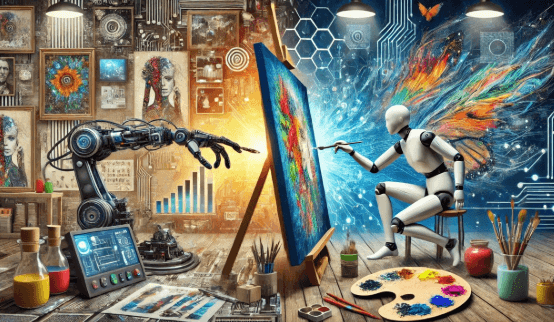AI-Powered Creativity: Exploring the Limits of AI Art

The integration of AI into artistic creation marks a significant shift in the landscape of art. By analyzing extensive datasets, AI tools generate artworks that challenge conventional aesthetics and techniques. While these creations exhibit impressive styles, they often lack the emotional resonance found in human-made art. This raises critical questions about the essence of creativity and the potential consequences of machine-generated expressions. What does this mean for the future of art and its inherent human connection?
The Evolution of AI in Artistic Creation
As technology has advanced, the integration of artificial intelligence into artistic creation has undergone significant transformation.
Machine learning algorithms now facilitate new forms of artistic collaboration, enabling artists to interact with AI systems in innovative ways.
This evolution has broadened the scope of creative expression, allowing for the generation of unique artworks that challenge traditional boundaries and redefine the role of the artist.
See also: The Rise of AI-Powered Virtual Influencers in Social Media
Analyzing AI’s Creative Process
While the creative processes of humans often involve intuition and emotional resonance, AI’s approach is fundamentally rooted in data analysis and pattern recognition.
Utilizing machine learning and generative algorithms, AI systems analyze vast datasets to identify trends and create novel outputs. This method allows for the generation of art that, while lacking emotional depth, showcases innovative combinations and unique styles, challenging traditional definitions of creativity.
The Role of Human Emotion in Art
Human emotion plays a pivotal role in the creation and appreciation of art, serving as a driving force behind artistic expression.
It fosters human connection, enabling artists to convey complex emotional narratives. This emotional expression not only enriches the artwork but also enhances the viewer’s experience, allowing for deeper engagement and understanding.
Thus, human emotion remains integral to the artistic process and its impact.
Ethical Implications of AI-Generated Art
The rise of AI-generated art has introduced a myriad of ethical implications that warrant careful examination.
Copyright concerns emerge as AI systems often utilize existing works, potentially infringing intellectual property rights.
Additionally, artist displacement raises questions about the role of human creativity in a landscape increasingly dominated by algorithms, challenging the traditional notions of authorship and economic sustainability within the art community.
Conclusion
In conclusion, the intersection of AI and art is akin to a double-edged sword, slicing through traditional boundaries while also raising profound questions about authenticity and emotion. As AI continues to evolve, its role in artistic creation will likely expand, fostering a unique collaboration between human intuition and machine precision. This dynamic relationship promises to redefine the essence of creativity, challenging both artists and audiences to reconsider the nature of art in an increasingly digital landscape.





